Huayna Potosí is a part of the Cordillera Real mountain range situated just 25 kilometers north of La Paz in Bolivia. It’s easily visible from the city and dominates the skyline.
This magnificent mountain stands tall at an elevation of 6088 meters, boasting a prominence of 1352 meters. In the local Aymara language, the name „Huayna Potosí“ translates to „Young Mountain,“ reflecting the indigenous heritage of the region.
Huayna Potosí is considered one of the easiest 6000 meters peaks in the world, which attract many climbers every year.
I have climbed the mountain this year and in this guide, I want to provide you with all the information you need for a successful and safe climb.
Why Choose Huayna Potosí?
- You can say you have climbed a 6000m high mountain.
- It’s one of the easiest 6000m climbs in the world.
- You can enjoy spectacular views from the summit and during the descent.
- You will try a real climbing experience.
- You will spend 2 or 3 days with a group of amazing people – similar to you – adventurers.
- If you choose a 3-day climb, you will try ice climbing.
- It’s very affordable. The price for the all-inclusive guided tour is very cheap compared to any other climbing experience.
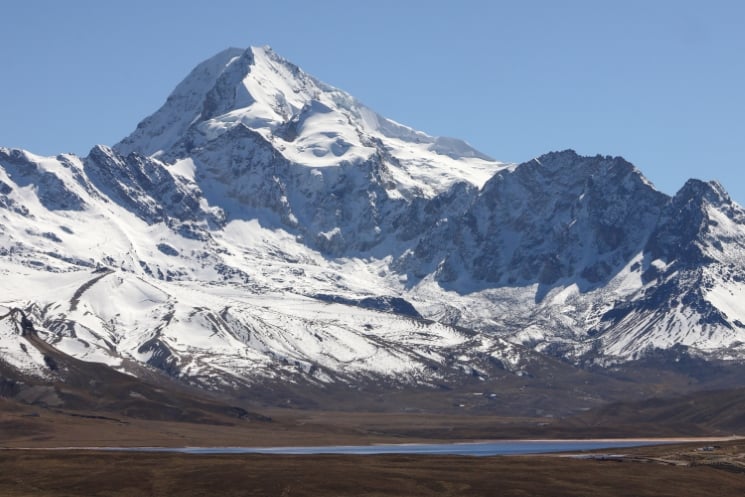
Best Time to Climb Huayna Potosi
The optimal period for climbing is generally during the dry season, which spans from May to September. During these months, the weather tends to be more stable, with clear skies and lower chances of precipitation. The dry conditions provide better traction on the glacier and reduce the risk of avalanches. Be also prepared that the temperatures might drop down to -20°C.
However, even during the dry season, weather conditions can change rapidly at high altitudes, and you must be prepared for sudden temperature drops and strong winds.
Definitely check the weather forecasts and consult with local guides or tour operators to ensure favorable climbing conditions.
The shoulder seasons of April and October can offer decent weather with fewer crowds. However, be prepared for colder temperatures and the possibility of occasional snowfall.
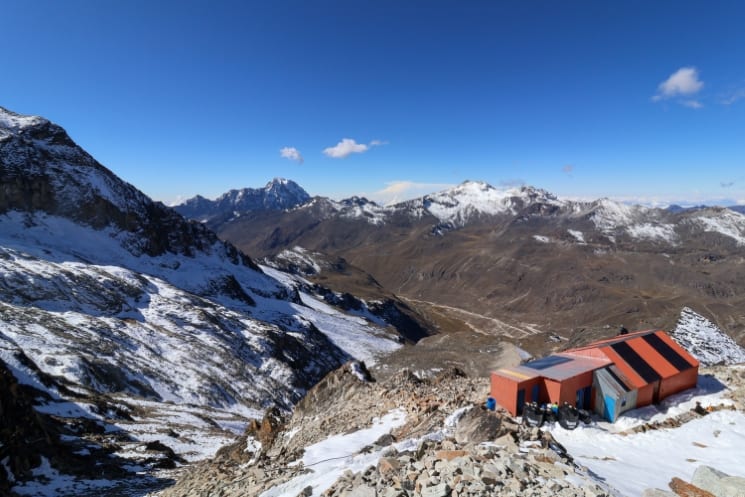
How hard is climbing Huayna Potosí?
Climbing to 6000 meters is hard! Very hard! You need to be really fit and in good physical condition to reach the peak.
You need to be able to climb 7 hours from 5100 to 6000 meters and after that another 7 hours to reach the base camp. That is 14 hours of high-demanding activity at a very high altitude.

Do you need previous climbing experience?
It’s true that Huayna Potosí can be climbed by complete beginners and previous climbing experience is not necessary. There is no real ice or glacier climbing (only training). However, it’s also true that you need to be prepared for climbing in high mountains because it’s no joke.
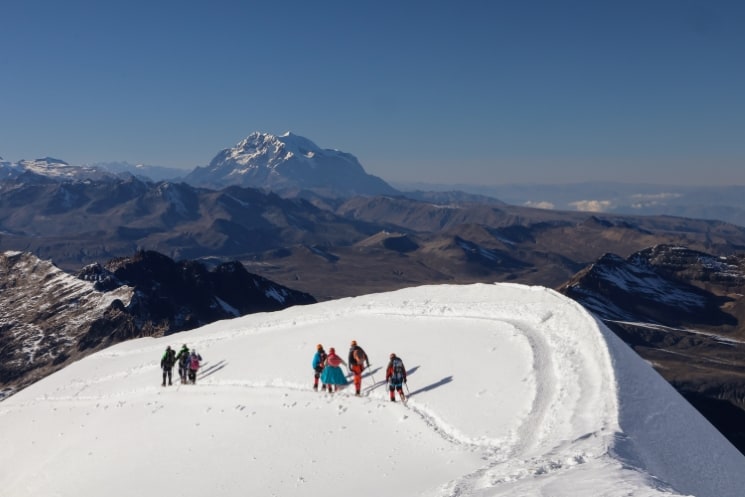
Is climbing Huayna Potosí dangerous?
Climbing Huayna Potosi, like any high-altitude mountain expedition, carries inherent risks and challenges. While it is considered a technically moderate climb, the altitude, and unpredictable mountain weather can pose dangers. It is crucial to approach the climb with proper preparation, caution, and the necessary skills.
However, it’s regarded as one of the easiest 6000-meter climbs in the world, so if you follow all the instructions below, it shouldn’t be that dangerous:
What should you do to avoid danger?
- Properly acclimatize for the high altitude – altitude sickness is a real danger. We write about the tips for acclimatization In the next section of this article.
- Properly check weather conditions – the weather on Huayna Potosi can change rapidly, with the potential for strong winds, snowstorms, and extreme cold temperatures. It is important to monitor weather forecasts and be prepared for adverse conditions.
- Check for potential rockfalls and avalanches – check the mountain forecast if there aren’t warnings for avalanche danger.
- Choose a reputable company – there are many companies doing the climb and some of them are well-experienced and some are pretty new. I choose Jiwaki, which is one of the most reputable companies and can only highly recommend them. Everything was very professional and safe.
- Check the provided gear – always check the gear you got from the company if it’s in good condition. Especially the harness, crampons, and helmet.
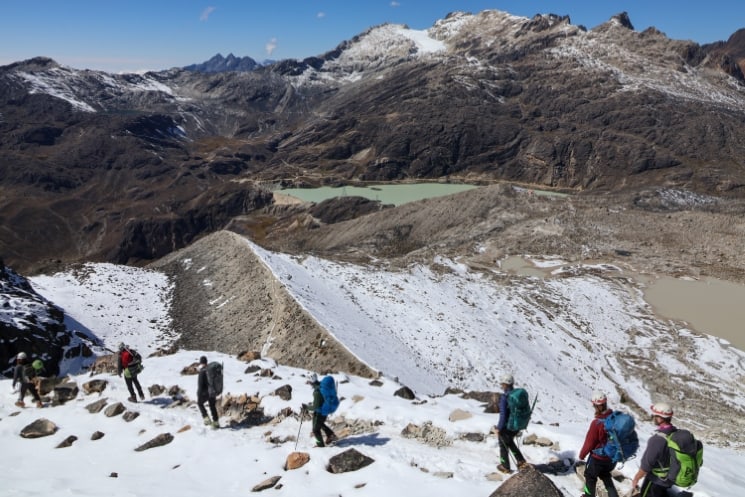
Altitude Sickness and Acclimatization Strategies
Altitude sickness during climbing to 6000 meters is no joke! You absolutely need not underestimate that! During our climb, one girl from our group was not properly acclimatized and got sick. She had to stop climbing and go back down to La Paz.
Here are some tips for acclimatization:
- Spend enough time at heights: the most important thing is to spend enough time in high altitudes around 4000-5000 meters before the climb. Ideally at least a week or two.
- Climb a smaller peak: a good idea is to climb a smaller peak such as Pico Austria before the climb.
- Ride Death Road: another good activity for acclimatization is riding the famous Death Road. The beginning is at almost 5000 meters and you will do a light physical activity, which is good for acclimatization.
- Chew coca leaves: coca leaves are the best medicine for altitude sickness. You can buy them easily everywhere and they are very cheap. I bought a whole package for the climb and it helped so much. They also provide a lot of energy and have plenty of beneficial vitamins.
- Drink a lot of water: and I mean A LOT! Even if you are not thirsty, just drink and drink. For instance, the guides recommended we bring 2 liters of water for the final climbing day. I brought 4 liters and drank it all easily.
- Buy a sports drink: bring with you some sports drinks such as Powerade or Gatorade. It helps you with hydration and energy.
- Drink coca tea: it should be always available in all the camps during the climb. Just don’t drink it in the evening because you might struggle to fall asleep.
- No alcohol: don’t drink any alcoholic drinks during the climb. Alcohol dehydrates and therefore is pretty bad for altitude sickness.

2-day vs 3-day climb to Huayna Potosí
Most companies offer 2-day and 3-day climbs to Huayna Potosí, so which should you choose?
Choose 3-day climb if you:
- want to enjoy the full experience.
- want to try ice climbing.
- need more acclimatization.
- want to spend more time with amazing people.
Choose 2-day climb if you:
- are tight on schedule and want to be there quickly.
- want to spend less money.
- Are fully acclimatized and don’t need more.
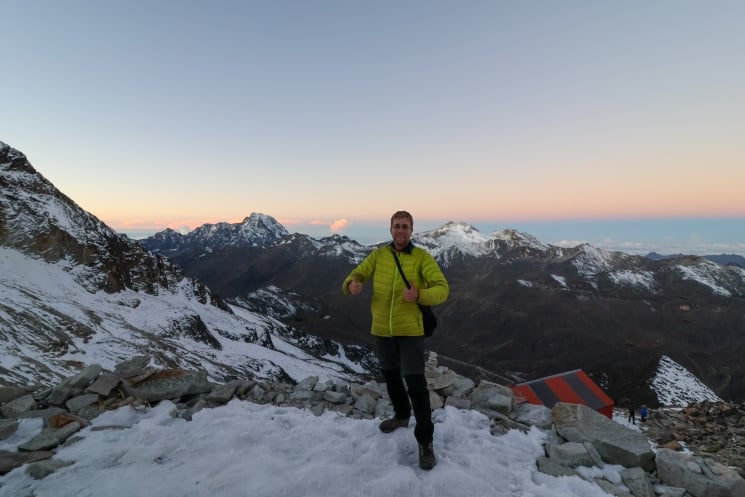
How big are the climbing groups?
The size of your group highly depends on the company you choose to climb with. I climbed with Jiwaki and the group was pretty big – 15 climbers plus guides. There were other companies with smaller groups of 5 or even 2 climbers.
Does the group size matter?
Not really. You will be in a big group only during the first two days. On the final summit day, the big group is split into groups of two, and every duo is assigned its own guide.
On the other hand, a bigger group is better for more fun and socialization.
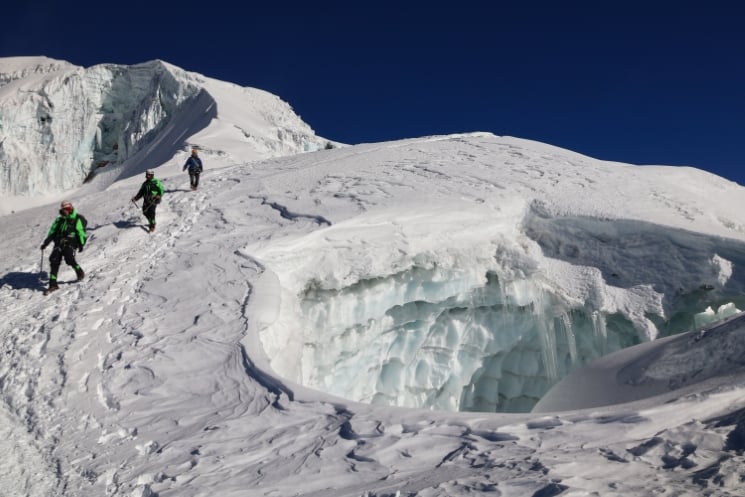
What equipment do you need for Huayna Potosi climb?
If you choose to climb with a reputable company, you don’t need much because all the important equipment will be provided by the company.
You need to bring:
- Layered clothing: pack a variety of lightweight, moisture-wicking base layers and insulating mid-layers. The provided waterproof outer layers are not very warm.
- Good socks: at least one pair for every day. Ideally two pairs for the final day.
- Inner gloves: the provided outer waterproof gloves are not very warm.
- Hat and buff: protect your head, ears, and neck from the cold and wind.
- Sunglasses: they are absolutely essential for eye protection against the intense sunlight and snow glare at high altitudes.
- Headlamp: the beginning of the final climb is at 1 AM, therefore you need a good headlamp. You can ask the company, if they can provide it.
- Hydration system: carry a water bladder or bottles to stay hydrated throughout the climb.
- Snacks: the food is provided 3 times a day during the expedition. However, you need some snacks for the final summit day. Bring some protein/muesli bars and chocolate.
- Sun block: the sun is very strong in such a high altitude. Bring a strong sun block to avoid being sunburned.
- Ear plugs: you might sleep in one room with about 15 people, so be prepared.
- Book or e-reader: you will spend a lot of time just waiting and acclimatizing in the refugees, therefore it’s a good idea to bring something to read. Or you can just play cards with the other climbers.
- Toilet paper: you need to bring your own.
- Personal medication
- Trekking poles: they are not absolutely necessary but I was very glad I took them. They help so much!
You will be provided:
- Mountaineering boots: sturdy, waterproof boots with good ankle support for glacier travel and climbing.
- Crampons: attachable metal spikes that provide traction on ice and snow.
- Ice axe: a crucial tool for self-arrest and stability while navigating icy slopes.
- Helmet: protects your head from falling objects and potential impacts.
- Harness: essential for glacier travel and rope management during roped sections.
- Rope and carabiners: you will be tight to your guide and your group partner with rope all the time during the last summit day.
- Waterproof gaiters: cover the lower legs and ankles to prevent snow, debris, and water from entering your boots.
- Waterproof jacket: essential against unpredictable weather.
- Waterproof gloves: also essential against unpredictable weather.
Possible to rent:
- 60 liters backpack: a durable and comfortable backpack with sufficient capacity to carry your gear, water, snacks, and extra layers. It should have a capacity of at least 60 liters to fit all necessary gear.
- Good sleeping bag: suitable for sub-zero temperatures, preferably with a rating that matches the expected weather conditions.
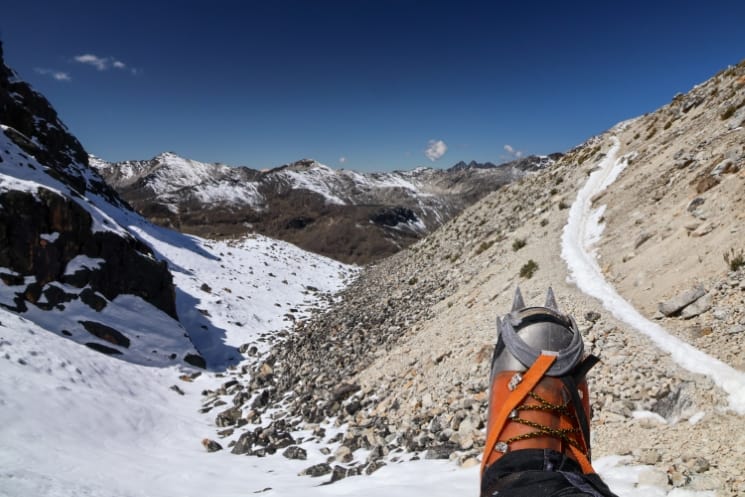
How is the food on the Huayna Potosí expedition?
The food is provided 3-times a day. The breakfast is usually bread with butter, marmelade, dulce de lece, bananas, muesli, coca tea, and coffee. Lunch and dinner are usually some meat with rice (there are also vegetarian options). The food was pretty decent for the conditions, where it is cooked.
Coca tea (and other flawors), water and some small snacks were available all the time.
You need to bring your own snacks for the final summit day.
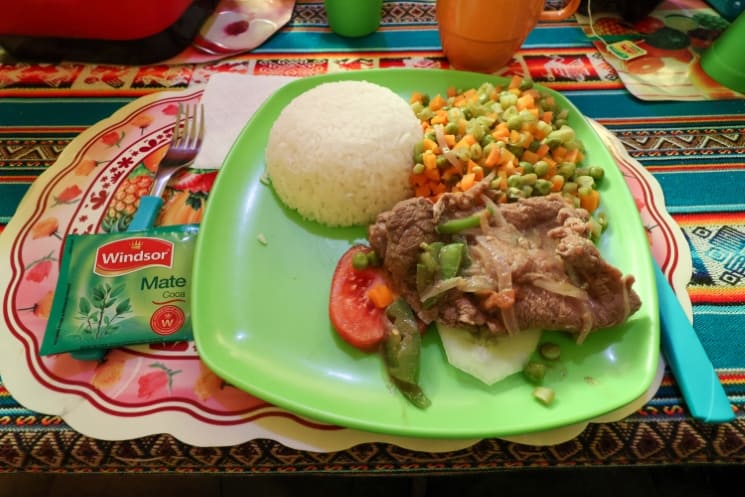
How is the accommodation on the Huayna Potosí expedition?
The accommodation is in mountain refugees, which are pretty basic but enough for a good sleep. You will sleep on bunk beds in a big shared room with other climbers, so be prepared and bring earplugs. You also need to have your own sleeping back (or rent one from the company), which is good for subzero temperatures.
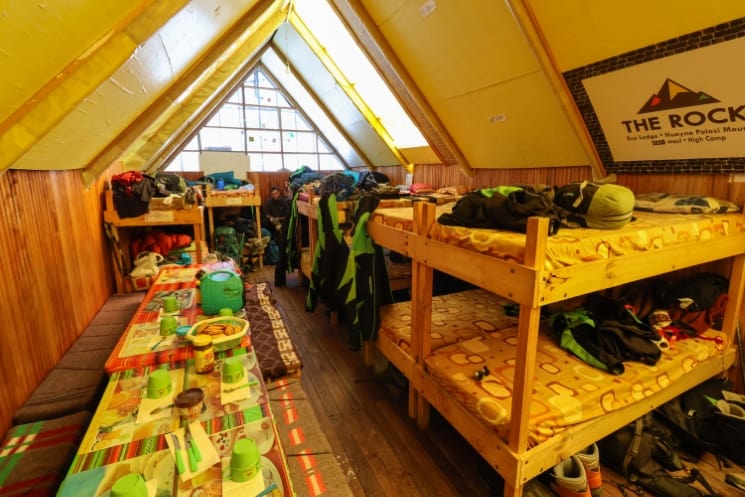
Personal experience of Huayna Potosi climb – day by day
I choose the 3-day climb of Huayna Potosí with Jiwaki company and it was absolutely amazing. I can highly recommend that, it was a lifetime experience.
Day 1: Preparation and ice climbing
We were pickup up by mini-van in front of the agency at around 9:00 am. The first stop on the way was to try boots and crampons and a last opportunity to buy coca leaves, snacks, and drinks.
The second stop was at a nice viewpoint, where we could see how massive Huayna Potosí really is – just breathtaking. It was also a time for a group picture.
At around 11 am, we reached the base camp at 4700 m, ate lunch, and prepared our backpacks for a day trip to the glacier ice climbing. We also had a first safety and organization briefing.
It took us around 2 hours of moderate uphill climb to the glacier. We needed the crampons only for the last few hundred meters. The first thing we did at the glacier was the training of climbing techniques we needed for the summit day.
After the training, the ice climbing began. It was actually one of the highlights of the expedition, therefore I would definitely recommend choosing the 3-day expedition over the 2-day. We climbed vertical ice wall, which might have been about 15 meters tall. The activity is optional, if you are too scared, you don’t need to climb. However, climbing with crampons and two ice axe was a lot of fun.
After the ice climbing it took us about 1,5 hours to get back to the base camp. Had dinner, played some games of UNO cards, and went to sleep pretty early.
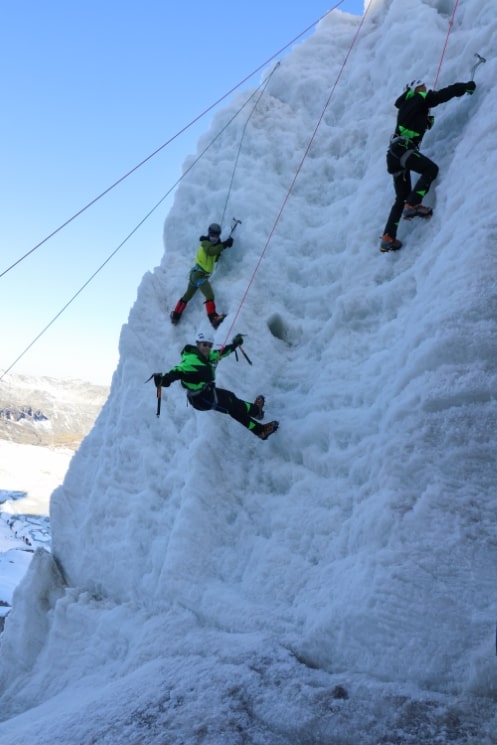
Day 2: Climbing to the high camp
Climb to second camp started after lunch therefore we had a lot of time in the morning to pack our backpacks, chat with other climbers, and play some UNO cards. I was drinking A LOT of water (and going to the bathroom a lot) and chewing a lot of coca leaves.
After lunch, it was time to climb to the high camp. It was pretty hard. We needed to climb from 4700 m to 5150 m on a very strenuous trail. We did many rest stops along the way. The first half to the National Park checkpoint (where you need to pay an entrance fee of 50 Bolivianos) was without crampons. The second part was all on icy terrain, therefore crampons were necessary.
It took us around 3 hours to reach the high camp and the views were already breathtaking, especially the sunset.
After a short rest, we had an early dinner and another safety briefing. We were also split into pairs and each pair was assigned its own guide.
We went to sleep at around 6:00 pm because of the very early wake-up. I was not able to fall asleep because of the high altitude and neverending thinking about the climb. Nevertheless even just laying in the bed was a good rest.
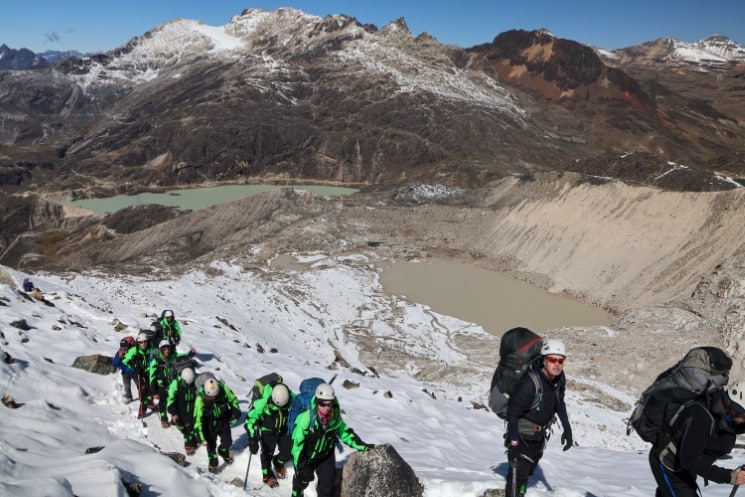
Day 3: Reaching the summit and returning to La Paz
The wake-up call was at midnight. We had breakfast, drank the last coca tea, and prepared our backpack to only take the necessary things and leave everything else in the camp. I was also able to take some photos of the incredible night sky with Huayna Potosí in the background. The climb started at 1:00 am. It was very dark, so good headlamp came handy.
The climbing tempo was very slow, which is essential at such a high altitude. Slow but steady. We were taking rest stops every 100 altitude meters. At each stop, I drank a lot of water and chew coca leaves.
It took us around 6 hours to reach the summit but the sunrise at the top was absolutely breathtaking. Our guide gave us enough time to enjoy the summit and take a lot of pictures.
The descent was actually one of the most rewarding things because the views were incredible. It took us around 3 hours to reach the high camp. We packed our backpacks, had a small lunch, and began descending to the base camp.
We returned all the provided gear, said the last goodbye to our guides, and rode back to La Paz. We were back in front of the agency at around 4:00 pm.
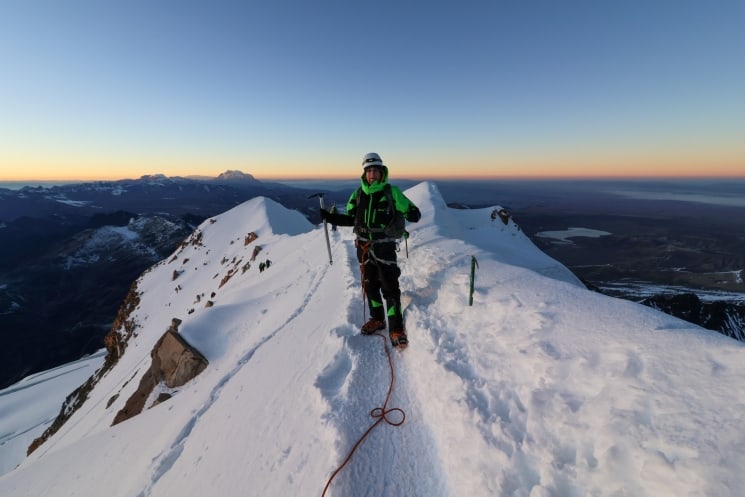
How hard was it for me?
The first two days I was feeling pretty fine. I was drinking a lot of water and chewing a lot of coca leaves., which helped. During the final summit day, I was feeling pretty fine till around 5700 meters, however, the last 300 meters were hard. My climbing buddy was struggling more than me, he even told me that he was few times thinking about giving up. But he did it too!
Out of 15 people from our group, 14 reached the summit. One girl was not properly acclimatized and got sick on the second day before even reaching the high camp. She had to give up and return to La Paz.
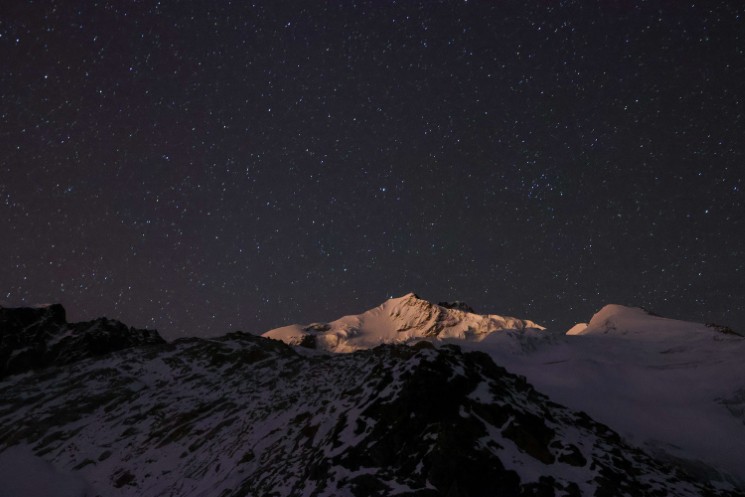
Which company to choose for climbing Huayna Potosí?
You need to climb Huayna Potosí with an experienced guide because otherwise it could be very dangerous and you could fall into some of the glacier crevasses.
There are many companies offering the expedition. I did a thorough research and choose to go with Jiwaki. They are one of the most reputable and experienced companies.
I was very satisfied with the whole experience and can only highly recommend Jiwaki (I am not sponsored by them).
- Everything was very professional.
- All the gear and equipment were in good condition.
- The main guides spoke decent English.
- All guides were very friendly.
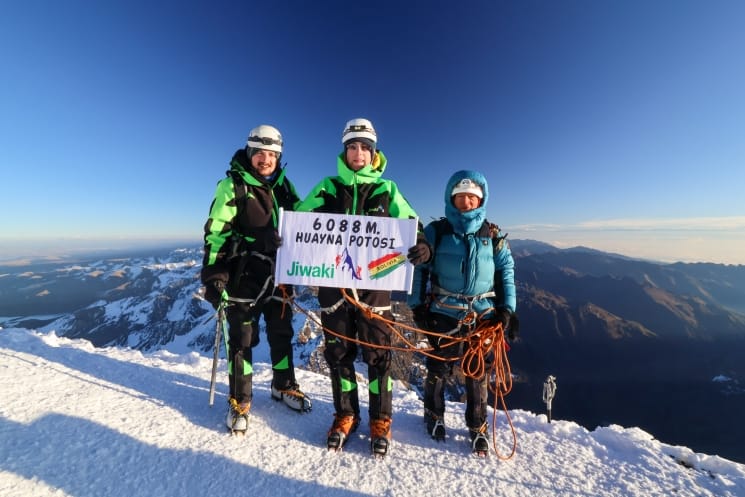
Read also:
Frequently Asked Questions:
Is there network coverage at Huayna Potosí?
No, not at all. Be prepared to be 3 days without internet. It’sgreat for socialization. The guides have satellite telephones if necessary.
How much should you tip your guide?
The general rule of thumb is to give around 10-15 USD (70-100 BOB) to your guide.
